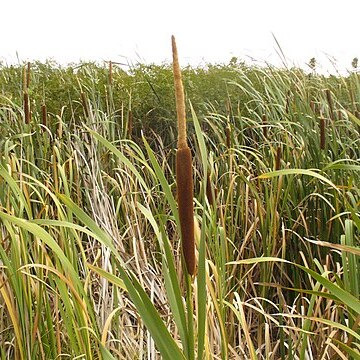A herb. The leaves are soft and dark green. The leaves are 1 m above the water and a few cm wide. The stems are taller than the leaves. They can be 2 m above the water. The flowers are on spikes at the ends of the stalks. Male flowers are light brown. Female flowers are dark brown. The fruit are very small and have one seed and many hairs.
Perennial herb, up to 2 m high, monoecious. Stem erect, simple, terminated by dense, cylindrical flower spikes. Leaves distichous, linear, apex obtuse, 0.4-1.5 m x 4-20 mm. Flowers: in a cylindrical spike with upper male portion 150-300 mm long, lower female portion shorter; brown or yellowish brown; Sep.-Apr.
Perennial herb, up to 2 m high. Stem erect, simple, terminated by dense, cylindrical flower spikes. Leaves distichous, linear, apex obtuse, 0.4-1.5 m long, 4-20 mm broad. Spike with upper male portion 150-300 mm long, lower female portion shorter. Flowers brown or yellowish brown.
Monoecious, tufted perennial to 2 m. Leaves strap-like, twisted, spongy. Flowers small, in cylindrical spikes, male flowers above and females below, brown.


